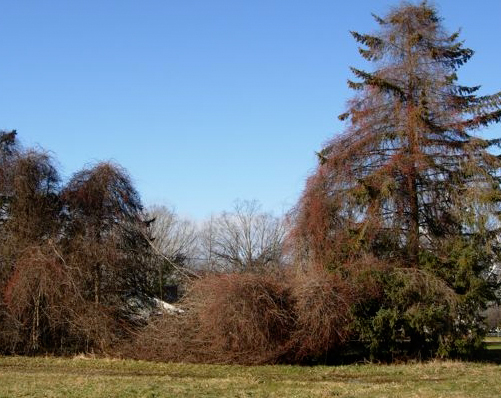
Non-Native Plants Thrive: A Study on Their U.S. Distribution

UMass Amherst
The first comprehensive assessment of native vs. non-native plant distribution in the continental United States found native plants are strongly limited in their distributions compared to non-native plants like this oriental bittersweet dominating a hedgerow, probably because people aren’t moving them around as much.
A new study, the first comprehensive assessment of native vs. non-native plant distribution in the continental United States, finds non-native plant species are much more widespread than natives, a finding that lead author Bethany Bradley at the University of Massachusetts Amherst called “very surprising.”
“Ecologists typically think of invasive species as being introduced in one spot and gradually spreading out from there. But, we found that even species with only a handful of occurrences were distributed all across the U.S.,” she says. “The future may already be here.”
As she explains, one of the major challenges for figuring out how species ranges could shift with climate change is that “we do not have a good handle on the factors limiting species’ current distributions. For non-native, invasive species in particular, predicting invasion risk is difficult because those species that have recently arrived may not have yet spread into all the environments where they could get a toehold.”
The international team the biogeographer led explored the geographic distributions of over 13,000 plant species, comparing those that are native and non-native to the continental United States, to identify differences in their overall geography. The work, which appears in the current online issue of Global Ecology and Biogeography, is co-authored with Regan Early of the University of Exeter, U.K., and Cascade Sorte of the University of California, Irvine.
Their comparative analysis highlights the fact that native plants are strongly limited in their distributions compared to non-native plants, probably because they have a harder time dispersing into suitable climates. That is, people aren’t moving them around as much, Bradley says.
The authors believe that this pattern is a result of widespread human introduction of non-native and invasive plants. Regionally, the ornamental plant trade and other human activities like planting of seeds with weed contaminants help non-natives overcome dispersal barriers that limit the distribution of native species.
“One silver lining for biological conservation is that native species are not so strongly limited by climate as once assumed,” she adds. In other words, native species’ distributions aren’t defined by their climate tolerances. Instead, other, non-climate-related dispersal barriers or interactions with other species can prevent native species from moving into environments where they could otherwise exist.
“With this study, we’re showing that inability to disperse, not climate tolerance, is likely stopping some species from inhabiting a broader range. This could mean that many species predicted to go extinct with climate change could persist for longer than previously anticipated under novel climates.”
But, Bradley warns, “Dispersal barriers aren’t going away, so even if native species can survive a little longer with climate change, most are clearly not going to be able to shift into newly suitable climate without our help.”
The researchers analyzed the distributions of 13,575 plant species (9,402 native, 2,397 endemic, 1,021 alien and 755 invasive) across the U.S. For each species, they recorded the total number of grid cells (roughly county-sized) occupied, calculated potential range based on climatic conditions, and measured their latitudinal and longitudinal extents. They then used the number of occupied and potential grids to calculate occupancy of potential range (range infilling) for each.
Bradley says although non-native and invasive species are much more widespread than natives, they have “filled in” much less of their potential range. Native species on average occupied about 50 percent more of their potential range than non-native species. For managers dealing with invasive species, Bradley says, “watch out.”
She adds, “We’re likely to see more problems from invasive species ahead as they continue to expand locally into suitable environments.” As the paper title states, invasive plants have plenty more space to invade.
This research was initiated during a working group supported by the National Center for Ecological Analysis and Synthesis (NCEAS) and supported by the Department of Defense’s Strategic Environmental Research and Development Program.
Contact Information
Bethany Bradley
401-440-9660
bbradley@eco.umass.edu
Janet Lathrop
413-545-0444
jlathrop@admin.umass.edu












